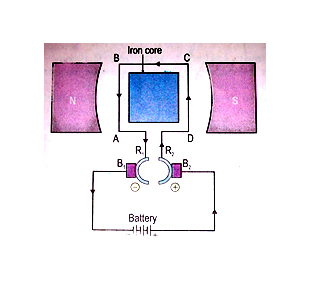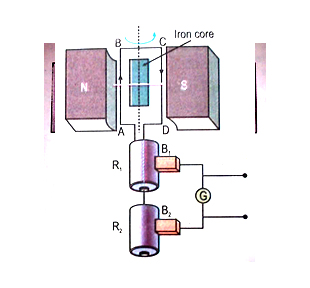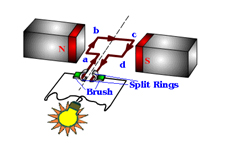SSC Worksheet for chapter-2 All About Electromagnetism class 10
Worksheet For class 10
This page is prepared by the Academic team of Physics Wallah which consists of SSC Board Worksheet for Class 10 Physics. Students of Class 10 Physics can get a free Worksheet for Class 10 Physics in PDF format prepared as per the newest syllabus and examination pattern in your schools.
Before solving the Worksheet for class 10 one must read the textbook of your school board exam and try to read the notes given in Physics Wallah class 10 notes sections. Students can also download free pdf of Class 10 Physics Notes prepared by teachers and solve important problems provided here with solutions on daily basis to get more scores in school exams and tests.
Physics Wallah worksheets for class 10 SSC can help students practice with tests and quickly revise lessons learned in the classroom with essential resources such as video lessons, short notes, and sample papers.
Class 10 Board is one of the most important year for every student and need a good planning and right study material to score good marks in your final exam. If any students need to take the online test to check their concepts or undertstanding then they can visit Physics Quiz for Class 10.
Fill in the blanks:
Q1. A generator produces ___________ .
Q2. Direction of induced current in a conductor is given by ___________ .
Q3. Direction of motion of a current –carrying conductor placed in a magnetic field is given by __________.
Q4. Electric generator works on the principle of ___________ .
Q5. ___________ is an instrument used to detect presence of current in a circuit.
Q6. In India, frequency of AC is ___________ Hz.
Subjective Type Questions
Q7. State the properties of magnetic lines of forces.
Q8. Write a note on
- Right hand thumb rule
- Fleming’s right hand rule
- Fleming’s left hand rule
Q9. Describe with a neat sketch the components and working of electric motor.
Q10. Describe with a neat sketch the components and working of.
- AC generator
- DC generator
Q11. Write a note on
- Electric fuse
- Earthing
- Short circuiting
- Over loading
- Solenoid
Q12. Write a note on various uses of DC motor.
Q13. What is Electromagnetic Induction?
Q14. Distinguish between direct current and alternating current.
Q15. An electric generator converts mechanical energy into electric energy. True or false
Q16. State any three characteristics of magnetic lines of force
Solutions
Ans 1. Electric current
Ans 2. Fleming’s right hand rule
Ans 3. Fleming’s left hand rule
Ans 4. Electromagnetic Induction
Ans 5. Galvanometer
Ans 6. 50
Ans 7.
- They seek the path of least resistance between opposite magnetic poles. In a single bar magnet as shown to the right, they attempt to form closed loops from pole to pole.
- They never cross one another.
- They all have the same strength.
- Their density decreases (they spread out) when they move from an area of higher permeability to an area of lower permeability.
- Their density decreases with increasing distance from the poles.
- They are considered to have direction as if flowing, though no actual movement occurs.
- They flow from the South Pole to the north pole within a material and north pole to south pole in air.
Ans 8. Right hand thumb rule
Imagine that you are holding a current carrying straight conductor in your right hand such that the thumb points towards the direction of current, then the curled fingers around the field, as shown in figure 5.6. This is known as the right hand thumb rule
- Fleming’s right hand rule
Stretch yours right hand's thumb, the index finger and middle finger in such a way that thumb represents direction of motion of conductor, the index finger ther direction of magnetic field, then the middle finger represents the direction of the induced current.
- Fleming’s left hand rule
Stretch the forefinger, the central finger and the thumb of your left hand mutually perpendicular to each other. If the forefinger shows the direction of the field and central finger shows the direction of the current, then the thumb will point towards the direction of the motion of the conductor.
Ans 9.

- Armature coil:A large number of turns of insulated copper wire wound on iron core in rectangular shape forms an armature coil ABCD as shown in the fig 5.14.
- Strong magnet:The armature coil is placed in between two pole pieces (N and S) of a strong magnet. This provides a strong magnetic field.
- Split ring commutator:It consists of two halves (R1 and R2) of a metallic ring. The ends of the armature coil are connected to direction of current in the armature coil.
- Brushes:Two carbon brushes B1 and B2 are used to press the commutator.
- Battery:The battery supplies the current to the armature coil
Working of the electric motor:
When current is passed through the coil ABCD, arms AB and CD experience force. According to Fleming’s left hand rule the force experienced by arm AB is in the downward direction and arm CD in the upward direction. Both these forces are equal and opposite. This force rotates the coil in clockwise direction until the coil is vertical. At this position, the contact between commutator and brushes break. So the supply to the coil is cut off. Thus no force acts on the coil. But the coil does not stop due to inertia. It goes on rotating until the commutator again comes in contact with the brushes B1 and B2. Again the current starts passing through coil and the arm AB rotates through 900, 1800, 2700 and 360 degrees. Now the force acting on arm AB is downward and CD is upward. Again this force moves the coil in clockwise direction.
Thus, the coil rotates with the help of electrical energy. The coil of DC motor continues to rotate in the same direction.
Ans 10.
(a) AC generator

Construction:The main components of AC generator are as shown in fig. 5.18
- Armature
- Strong magnets
- Split rings and
- Brushes
Armature, strong magnets and brushes are the same as used for electric motors.
Slip rings: The two ends of the armature coil are connected to two brass slit rings R1 and R2. These rings rotate along with the armature coil.
Working:
When the armature coil ABCD rotates in the magnetic field provided by the strong magnets, it cuts the magnetic lines of forces. Thus the changing magnetic field produces induced current in the coil. The direction of induced current is determined by the Fleming's right hand rule.
The current flows out through the brush B1 in one direction in the first half of the revolution and through the brush B2 in the next half revolution. In the reverse direction, this process is repeated. Therefore, the induced current produced is of alternating nature. Such a current is called as alternating current.
(b) DC generator

Construction: The main components of DC generator are
- Armature coil
- Strong magnet
- Split rings or commutator
- Brushes
- Bulb
The components such as armature coil, strong magnet, brushes are the same which are used for AC generators.
Split ring or commutator is the same as used in electric motor.
Bulb: The output is shown by the glowing bulb connected across the carbon brushes.
Working: The commutator rotates with the loop of wire just as the slip rings do with the rotor of an AC generator. Each half of the commutator ring is called a commutator segment and is insulated from the other half. Each end of the rotating loop of wire is connected to a commutator segment. Two carbon brushes connected to the outside circuit rest against the rotating commutator. One brush conducts the current out of the generator, and the other brush feeds it in. The commutator is designed so that, no matter how the current in the loop alternates, the commutator segment containing the outward-going current is always against the "out" brush at the proper time. The armature in a large DC generator has many coils of wire and commutator segments. Because of the commutator, engineers have found it necessary to have the armature serve as the rotor (the rotating part of an apparatus) and the field
structure as the stator (a stationary portion enclosing rotating parts)
Ans 11. Write a note on
- Electric fuse: Fuse, Electric, a protective device for breaking an electric circuit. A fuse consists essentially of a metal strip or wire that melts at a lower temperature than the wire and other components in the rest of the circuit. The fuse is connected in series with the source of electric power. When the current flowing in the circuit becomes too strong, it heats the fuse so that it melts, breaking the circuit.
- Earthing: Earthing is a safety device used to prevent a shock due to leakages arising from weak insulation, breaking of the element or otherwise. The metal bodies of appliances handled like the electric iron, kettle or refrigerator must be earthed, that is, connected to a pipe leading deep into the earth on to a metal plate. In case the metal body becomes live, the circuit is completed through the live wire and the earth, resulting in a high current..
- Short circuiting: As such the words suggest, the circuit becomes shorter. If there is a failure in insulation or some other means by which the two wires (phase and neutral) comes into electrical contact, the circuit gets shortened as the current always chooses the path which has got least resistance. Since the resistance of the shorted circuit is less a heavy current flows.
- Over loading: In house hold circuiting we are using parallel combination of the different appliances. Every instrument is connected in parallel to the supply. Whenever a new apparatus is switched on, it draws more current. If the current drawn by all the devices connected in a circuit is more than the maximum current rating for the given circuit, the condition is called overloading.
- Solenoid: A coil of many turns of insulated copper wire wrapped in the shape of cylinder is called a solenoid.
Ans 12.
- These motors are used in domestic appliances like mixers, blenders, refregirators and washing machines.
- (hese motors are used in electric fans, hair dryers, record players, tape recorders and blowers.
- These motors are used in electric cars, rolling mills, electric cranes, electric lifts and electric trains.
Ans 13. The phenomenon of producing an induced e.m.f. in a conductor or conducting coil due to changing magnetic flux is called electromagnetic induction.
Ans 14.
|
Improve this chart |
Alternating Current |
Direct Current |
|---|---|---|
|
Amount of energy that can be carried: |
Safe to transfer over longer city distances and can provide more power |
Voltage of DC cannot travel very far until it begins to lose energy |
|
Flow of Electrons: |
Electrons keep switching directions - forward and backward |
Electrons move steadily in one direction or 'forward' |
|
Cause of the direction of flow of electrons: |
Rotating magnet along the wire |
Steady magnetism along the wire |
|
Frequency: |
The frequency of alternating current is 50Hzor 60Hzdepending upon the country. |
The frequency ofdirect currentis zero. |
|
Direction: |
It reverses its direction while flowing in a circuit |
It flows in one direction in the circuit |
|
Current: |
It is the current of magnitude varying with time |
It is the current of constant magnitude |
|
Obtained from: |
A.C Generator and mains |
Cell or Battery |
|
Power Factor: |
Lies between 0 & 1 |
it is always 1 |
Related Link
- Class 10 Physics Notes
- Class 10 Chemistry Notes
- Class 10 Biology Notes
- Class 10 Maths Notes
- Chapter Wise Quiz Class 10 Physics
- Chapter Wise Quiz Class 10 Chemistry
- Chapter Wise Quiz Class 10 Biology
- Chapter Wise Quiz Class 10 Maths
- Previous year Board Papers
- Sample Papers Maths Class 10
- Sample Papers Science Class 10
- NCERT Maths Solutions Class-10









